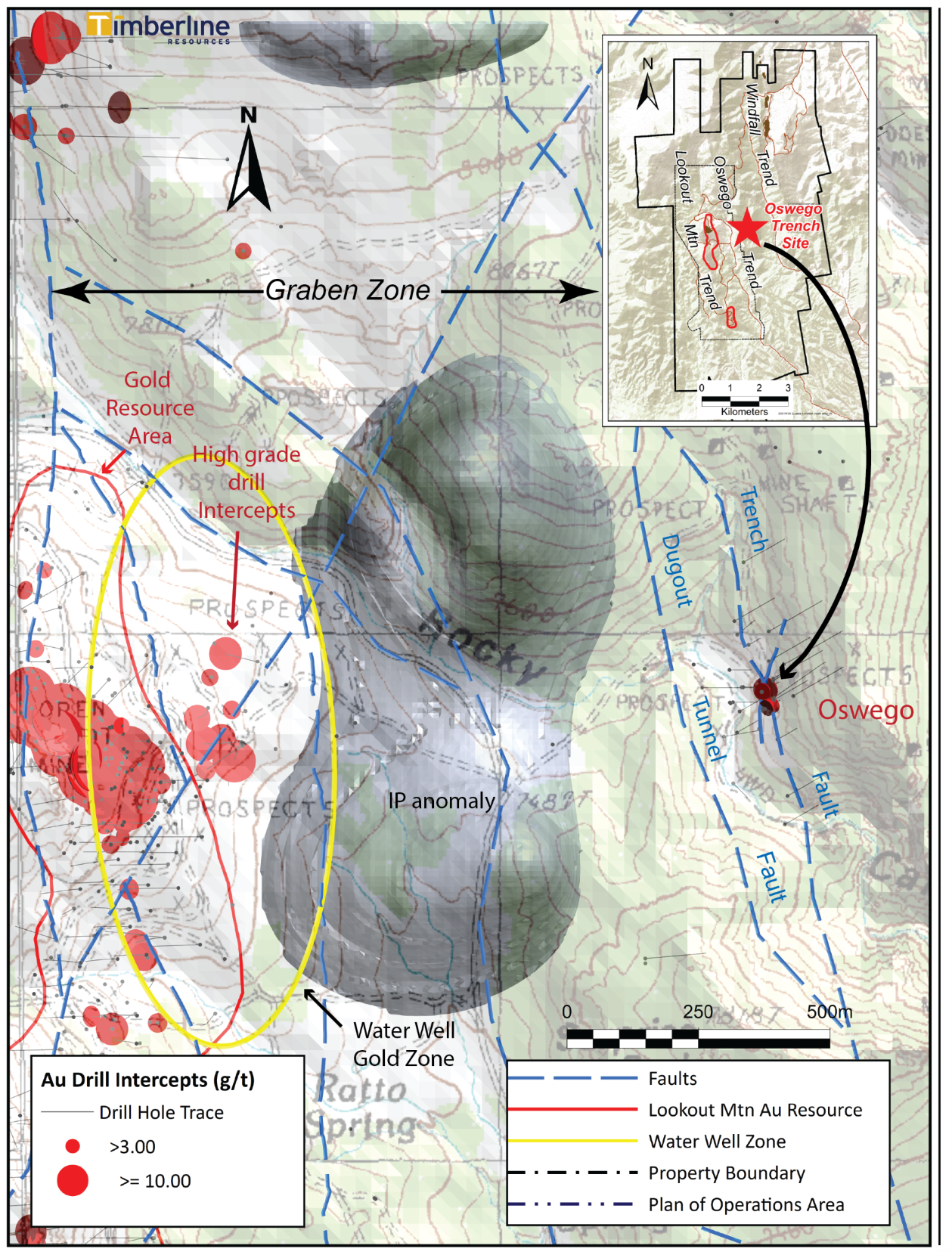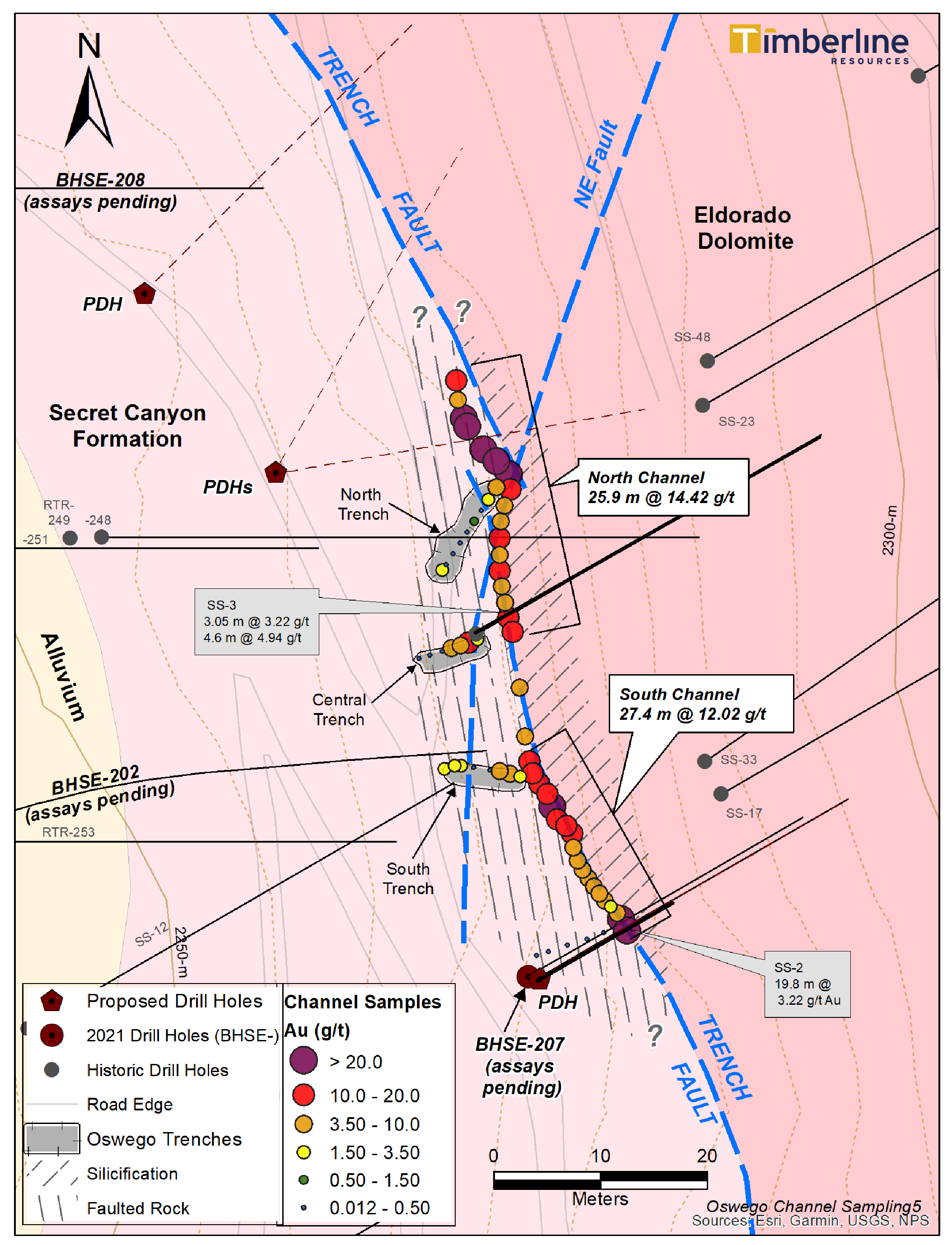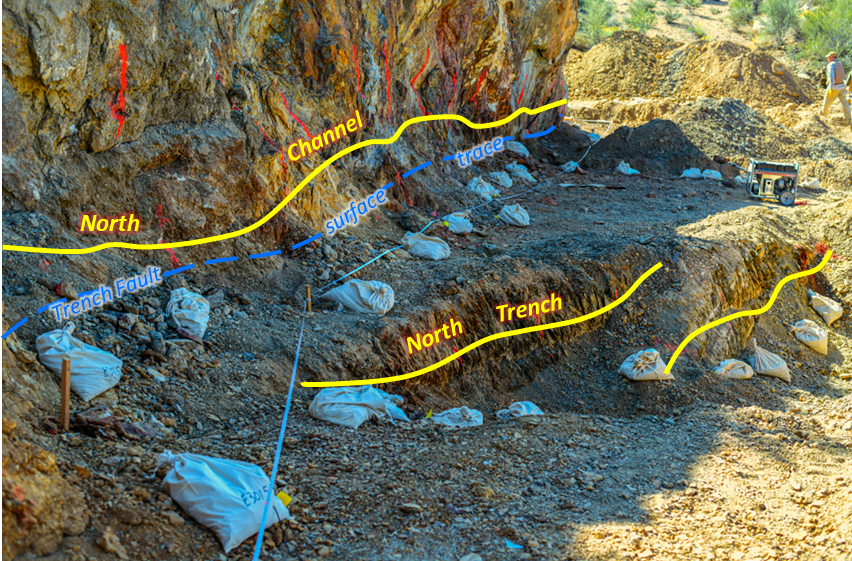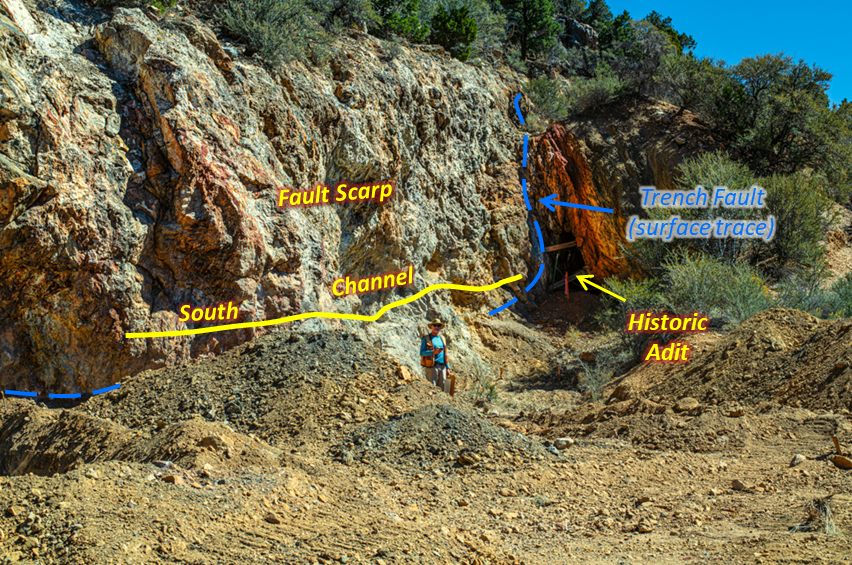Coeur d’Alene, Idaho – December 6, 2021 – Timberline Resources Corporation (OTCQB: TLRS; TSX-V: TBR) (“Timberline” or the “Company”) announced today results of a systematic channel sampling campaign at the Oswego Gold Occurrence on the Eureka Gold Project in Nevada. Company geologists collected 67 channel and rock samples along the 65-metre strike length of exposed fault scarp, where historic results had indicated the presence of high-grade gold. The sampling was focused along the Trench Fault and associated cross structures. The zone of alteration and mineralization is approximately 10 metres wide, pervasively oxidized at surface, and remains open along strike and downdip. Results of the new Oswego channel and trench samples are summarized in Table 1.
The Oswego gold occurrence is located 1.2 km east of the Lookout Mountain gold resource and is along a splay of the Dugout Tunnel Fault (DTF) – a major structural break and interpreted eastern control on gold mineralization in the broader Lookout Mountain-Oswego corridor (Figure 1). All of these samples were taken from Timberline’s patented claim that encompasses the roadcut and minor historical prospect pits and adits. The Company is currently drilling along the structure to follow-up on these surface results.
Table 1. Summary of Oswego Channel Sample Gold Assay Results (No cutoff grade applied)
Patrick Highsmith, Timberline’s President & CEO, commented on the significance of the Oswego sampling, “These new results from our Oswego Target are extremely exciting. The Trench Fault is continuously mineralized for at least 65 metres and remains open along strike and down dip. The consistency of grade and oxidation at surface is also very encouraging. This systematic sampling has been very helpful in designing the drillholes that are still underway. We look forward to assessing the growth potential of the Oswego Target once we have the assays in from the drilling.”
Figure 1. Location of the Oswego Gold Occurrence Relative to the Lookout Mountain Resource

Geology and Drilling Plans
The Oswego Trend has been noteworthy for both high-grade oxide gold in the vicinity of these trenches and high-grade silver and polymetallic mineralization farther to the northeast at the historical Geddes Bertrand Mine (see Company news release dated June 12, 2018). However, until the current program, there has been no drilling on the trend since approximately 1991. The major Dugout Tunnel Fault system strikes northwest through the area, including an eastern splay termed the Trench Fault. These faults dip nearly vertical and juxtapose the Cambrian Secret Canyon Formation against the older Eldorado Dolomite. The Eldorado is well known in the district as an important host of silver-lead-zinc+gold mineralization, and the Secret Canyon is interpreted to be a suitable host for Carlin-type gold mineralization.
The gold mineralization encountered in these trenches occurs in two primary units. The highest-grade mineralization occurs along the footwall fault scarp in intensely silicified Eldorado Dolomite with variable iron oxide. The silicification and iron oxide along the fault scarp are readily identifiable (see Figures 3a and 3b) and remarkably consistent in its gold content (ranging from 3.33 to 26.2 g/t Au in these channel samples). Timberline believes the siliceous fault zone continues to the north beneath detritus and slide material. The extent of silica alteration in the Eldorado to the east of the fault is not yet known due to access limitations and difficulty of sampling, but there appears to be considerable potential to expand the silicified gold zone to the east.
The lower shale member of the Secret Canyon Shale hosts the balance of the lower-grade gold identified in these trenches. The Secret Canyon, where it occurs in the hanging wall of the fault, is consistently mineralized, commonly highly foliated, enriched in iron oxide, and decalcified. Based on some of the trenches, the true width of mineralized Secret Canyon within the Trench Fault system is interpreted to be at least 11 metres.
While anomalous gold and silver occur over a larger area at Oswego, the focus of this year’s work is to test the high-grade mineralized Trench Fault by surface sampling and drilling. Most previous drilling at Oswego focused on historical workings east of the Dugout Tunnel Fault System. The historical drill results are summarized in Table 2. Timberline has already completed drill hole BHSE-207 across the Trench Fault near the southern end of these channel samples. Several more holes have been drilled farther west to test for downdip mineralization on the faults, and a few more are underway at various places along the Trench Fault (Figure 2). Multi-element analyses on the channel samples are also still pending.
Timberline has now confirmed high-grade gold mineralization by drilling and trenching at several locations in the corridor between the Lookout Mountain Resource and the Oswego Zone. Drill intercepts exceeding 3.0 and 10.0 g/t gold are shown on Figure 1. Timberline’s efforts during 2021 are focused at the Water Well Zone (WWZ) and Oswego Target, which are outside the existing gold resources. The Company also drilled a core hole to test the IP anomaly that occupies the central axis of the 1.25 km (±) wide Graben Zone.
At the WWZ, seven drill holes (a combination of core and reverse circulation) have been completed in the current round of drilling to test its northern extent, with an additional three holes in progress and three more planned. Results of this drilling will be reported as assays are received.
Sampling Methodology
Continuous rock chip samples were collected from the north, central, and south trenches which cut the Trench Fault (Figure 2) and extend into the western, hanging wall side of the subvertical fault. Geologists collected samples over nominal 1.5-metre intervals along mechanically chipped or sawn channels measuring approximately 10 cm wide x 5 cm deep. The samples in this campaign average approximately 12 kilograms. The 12-metre gap between the north and south channels was not sampled due to unstable ground (Figure 3a and 3b).
Figure 2. Geologic Map of the Oswego Gold Occurrence with Channel Sample Locations and Results

Historical Drilling
As previously reported, Oswego is a site of limited historical mining and more modern prospecting and drilling dating back to the 1980s and 1990s. The Timberline database includes at least partial data for approximately 10 drill holes at the Oswego occurrence (see Figure 2 and Table 2). Of these holes, only three appear to have drilled across the Trench Fault – the host of most of the gold reported from this sampling campaign. Holes SS-2 and SS-3 intercepted high-grade gold (≥ 3 g/t) at shallow depths beneath the channel samples. No assay or lithologic data are available for a third hole, RTR-248.
Figure 3a. Perspective View of North Channel Sampling and the Surface Trace of the Trench Fault along with North Trench. Sample bags shown alongside 1.5m intervals from channel cuts.

Figure 3b. South Looking View of the South Channel and the Surface Trace of the Trench Fault.

The Company recovered most of these drill hole collar locations, and it is clear that the Trench Fault zone has not been thoroughly drill tested.
Table 2. Historical and Recent Drill Holes at the Oswego Gold Occurrence
Cautionary Statement
*These historic drill data should not be relied upon. A Qualified Person, as defined by National Instrument 43-101, has not done sufficient work to verify the historical drill information presented here. It is provided here only for context and to support the Company’s assessment of prospectivity of the target. Timberline has made considerable effort to compile and review historic drill logs and laboratory assay certificates, where available. In most cases, collar locations have also been located and surveyed. Considerable additional drilling and analysis will be required to verify the historical information or generate a valid mineral resource.
Sampling Methodology, Chain of Custody, Quality Control and Quality Assurance
These channel samples were collected under the supervision of Timberline personnel. Personnel from Timberline transported the samples to the Company’s secure Eureka facility, where the samples were sorted, tagged with bar-coded sample numbers, and later delivered to ALS USA Inc. (ALS) in Elko, Nevada for sample preparation. Timberline has rigorous quality control measures in place at the Eureka Project, including the insertion of blind certified standard reference materials, field duplicates, and blanks. ALS assayed the samples for gold by fire assay of a 30-gram charge with an AA or ICP-ES finish (ALS code Au-AA23). The overlimits for gold samples assaying above 10 g/t were determined by a 30-gram fire assay with gravimetric finish. Samples above 0.2 g/t Au were also re-analyzed by cyanide leach (ALS code Au-AA13). In addition, gold mineralized samples are subjected to multi-element analysis (33 elements) by four-acid digestion and ICP-ES determination (ALS code ME-ICP61); the multielement results are pending.
Steven Osterberg, Ph.D., P.G., Timberline’s Vice President Exploration, is a Qualified Person as defined by National Instrument 43-101 and has reviewed and approved the technical contents of this release. Dr. Osterberg is not independent of the Company as he is an officer.
About Timberline Resources
Timberline Resources Corporation is focused on delivering high-grade Carlin-Type gold discoveries at its district-scale Eureka Project in Nevada. The Eureka Property includes the historic Lookout Mountain and Windfall mines in a total property position of approximately 24 square miles (62 square kilometers). The Lookout Mountain Resource was reported in compliance with Canadian NI 43-101 in an Updated Technical Report on the Lookout Mountain Project by Mine Development Associates, Effective March 1, 2013, filed on SEDAR April 12, 2013 (see Cautionary Note to US Investors below).
The Company is also operator of the Paiute Joint Venture Project with Nevada Gold Mines in the Battle Mountain District. These properties all lie on the prolific Battle Mountain-Eureka gold trend. Timberline also controls the Seven Troughs Project in northern Nevada, which is one of the state’s highest-grade former gold producers. Timberline controls over 43 square miles (111 square kilometers) of mineral rights in Nevada. Detailed maps and mineral resources estimates for the Eureka Project and NI 43-101 technical reports for its projects may be viewed at https://timberlineresources.co/.
Timberline is listed on the OTCQB where it trades under the symbol “TLRS” and on the TSX Venture Exchange where it trades under the symbol “TBR”.
On behalf of the Board of Directors,
“Patrick Highsmith”
President and CEO
Tel: 208-664-4859
Cautionary Note to U.S. Investors: The terms “mineral resource,” “measured mineral resource,” “indicated mineral resource” and “inferred mineral resource,” as used on Timberline’s website and in its news releases are Canadian mining terms that are defined in accordance with National Instrument 43-101 – Standards of Disclosure for Mineral Projects (“NI 43-101”). These Canadian terms are not defined terms under United States Securities and Exchange Commission (“SEC”) Industry Guide 7 and are normally not permitted to be used in reports and registration statements filed with the SEC by U.S. registered companies. The SEC permits U.S. companies, in their filings with the SEC, to disclose only those mineral deposits that a company can economically and legally extract or produce. Accordingly, note that information describing the Company’s “mineral resources” is not directly comparable to information made public by U.S. companies subject to reporting requirements under U.S. securities laws. U.S. investors are urged to consider closely the disclosure in the Company’s Form 10-K which may be secured from the Company, or online at http://www.sec.gov/edgar.shtml.
Forward-looking Statements: Statements contained herein that are not based upon current or historical fact are forward-looking in nature and constitute forward-looking statements within the meaning of Section 27A of the Securities Act of 1933 and Section 21E of the Securities Exchange Act of 1934. Such forward-looking statements reflect the Company’s expectations about its future operating results, performance and opportunities that involve substantial risks and uncertainties. These include, but are not limited to, statements regarding the advancement of projects, and exploration potential. When used herein, the words “anticipate,” “believe,” “estimate,” “upcoming,” “plan,” “target”, “intend”, “growth opportunity” and “expect” and similar expressions, as they relate to Timberline Resources Corporation, its subsidiaries, or its management, are intended to identify such forward-looking statements. These forward-looking statements are based on information currently available to the Company and are subject to a number of risks, uncertainties, and other factors that could cause the Company’s actual results, performance, prospects, and opportunities to differ materially from those expressed in, or implied by, these forward-looking statements. Factors that could cause or contribute to risks involving forward-looking statements include, but are not limited to, changes in the Company’s business and other factors, including risk factors discussed in the Company’s Form 10-K for the year ended September 30, 2020. Except as required by law, the Company does not undertake any obligation to release publicly any revisions to any forward-looking statements.
Neither the TSX Venture Exchange nor its Regulation Services Provider (as that term is defined in the policies of the TSX Venture Exchange) accept responsibility for the adequacy or accuracy of this release.
